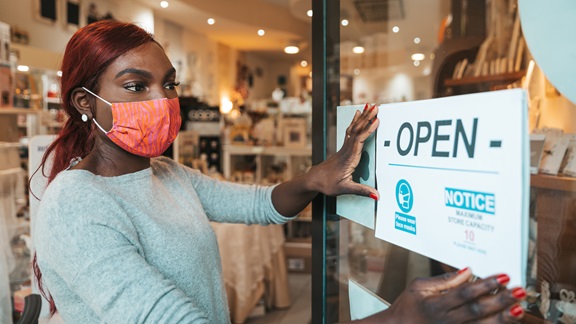With the economy reeling from the COVID-19 pandemic, the U.S. unemployment rate spiked from 3.5 percent in February 2020 to 14.7 percent in April 2020—a two-month increase unprecedented in the history of U.S. unemployment data. The recovery has also been striking in its size and speed. The national unemployment rate fell to 6.9 percent in October 2020, while in September 2020 unemployment rates in the Ninth Federal Reserve District had fallen to 4.1 percent in South Dakota (down from 10.9 percent in April) and 8.5 percent in Michigan (down from 24.0 percent in April).1 Through an analysis of recent economic data and insights gleaned from conversations with community stakeholders, we see evidence of profound economic hardship during the recovery—but also some signs of hope.
The rise and fall of unemployment
The sharp rise and fall of temporary unemployment was the driving force behind shifts in unemployment during the pandemic. (See Figure 1.) In April 2020, the 11.5 percent of the labor force who believed their layoff to be temporary represented the large majority of total unemployment. As employers recalled temporarily laid-off workers, that total unemployment rate declined rapidly. At least in retrospect, this is unsurprising: it is much quicker for workers to return to their previous employers than to find entirely new employment.
Temporary unemployment has declined since its April 2020 peak
Note: Data are seasonally adjusted. Temporary unemployment consists of workers who expect to return to their prior jobs within six months, or who have been provided with a specific recall date. Entrant unemployment consists of workers who have entered or re-entered the labor force to search for work. Permanent unemployment consists of all other unemployed workers.
Source: Bureau of Labor Statistics 2020 and Local Area Unemployment Statistics 2020.
However, permanent unemployment has risen since the spring 2020 peak as some of the temporarily unemployed learned they would not return to their jobs and others were permanently laid off. In October 2020, permanent unemployment accounted for nearly half of total unemployment. These workers will have a more difficult time re-entering the workforce, since they cannot return to their previous jobs.
Adding to the challenge for some workers is the pandemic-induced, accelerated demand for broadband access during the hiring process. According to Julie Brekke, executive director of Hired, a Minneapolis-based nonprofit that works to advance economic opportunity through employment and career services, the digital divide not only affects children who are distance learning but also impacts adults who are looking for work: “For people who don’t have access to the Internet, the current situation can make it very difficult to find jobs, as people need to apply for jobs and also learn how to interview online.”
Another challenge is that many low-wage workers, especially but not only in rural areas, are struggling to balance work and parenting responsibilities. Tuleah Palmer, president and CEO of the Blandin Foundation in Grand Rapids, Minnesota, noted, “The need for child care right now is hitting low-income families hard. If you’re a low-wage worker and school schedules keep changing—say, with hybrid classes to start, and then suddenly all distance learning—and if you have two or three kids that need to be in child care in order for you to work, the cost of child care becomes larger than what someone would earn in wages.” This dynamic could help explain why the share of the 16-and-older population that is in the labor force at all (whether employed or unemployed) has fallen by 1.7 percentage points from February to October.
Long-term unemployment on the rise
For tens of millions of American workers who lost their jobs during the pandemic, unemployment insurance (UI) has provided a crucial financial support. Continued claims provide a rough measure of how many people receive UI and can inform understanding of closely linked labor market conditions.
More and more UI recipients are exhausting their regular benefits, typically after 26 weeks, and now rely on Pandemic Emergency Unemployment Compensation (PEUC), the additional 13 weeks of benefits provided by the Coronavirus Aid, Relief, and Economic Security (CARES) Act. (See Figure 2.) Without additional policymaker action, those PEUC benefits will expire at the end of December 2020 (even for workers who have not yet exhausted them). The long-term unemployed who are eligible for PEUC tend to be particularly economically insecure, given that they have endured at least half a year without their previous wages. And troublingly, workers who have been unemployed for long stretches of time (e.g., longer than six months) tend to have a lower chance of finding jobs than those with shorter unemployment, as hiring managers may discriminate against applicants with longer spells of unemployment.
Unemployment insurance claims reveal declining total unemployment but rising long-term unemployment
Note: Data are not seasonally adjusted. PEUC refers to Pandemic Emergency Unemployment Compensation, an additional 13 weeks of federally funded benefits available to recipients who exhaust their regular benefits. State insured unemployment rates include only regular claims.
Source: U.S. Department of Labor 2020.
An uneven recovery and uneven hardships
The recovery has been both uneven and inconsistent across demographic groups. For workers of color, the unemployment rate is persistently higher than that of White workers. But this gap is not constant through the business cycle: racial disparities expand during economic downturns. In October 2020, the White unemployment rate for the U.S. as a whole stood at 6.0 percent, well below the 7.6 percent, 8.8 percent, and 10.8 percent unemployment rates for Asian, Latino/a, and Black workers, respectively.2 (See Figure 3.) Similar disparities in unemployment rates exist in state-specific data as well (for example, in Minnesota). The Asian and Black unemployment rates have fallen especially slowly from their April 2020 peaks, raising concerns about Asian and Black workers’ inclusion in the ongoing recovery.Underlying these overall trends are widely varying experiences by geography as well. In many parts of the Ninth District, recovery from the recession can be described in terms of the haves and the have nots. People who have remained employed throughout the pandemic saw an income boost from CARES Act stimulus payments to individuals. Also, because of low interest rates, many have refinanced their homes, which reduced their debt load and monthly mortgage payments and increased their cash flow.
The picture for low-income communities has been very different, however. Mike Temali, founder and CEO of Neighborhood Development Center, a nonprofit community development organization in St. Paul, Minnesota, noted, “Many low-income communities were already experiencing high unemployment and recession-like conditions before COVID hit.” The current crisis is only exacerbating economic conditions that were already extremely challenging for low-income families.
What to expect in the coming months
What can we infer about the likely strength of the recovery as it continues into 2021? On the one hand, the falling share of the unemployed who are only temporarily laid-off is a reason for pessimism, as they have been the workers with the easiest path to re-employment. Moreover, policy supports like the Paycheck Protection Program and the individual COVID-19 stimulus payments have lapsed. Unless these or similar policies are revived or enacted in the coming months, the labor market recovery may slow down.
One bright spot is the explosion in business openings, which bodes well for the labor market recovery. Typically, start-ups are responsible for about 20 percent of hiring. While the usual relationship between business openings and hiring may or may not exist in the pandemic recession, the surge in new business formation is a welcome development.
After business openings dropped by as much as 40 percent (relative to one year prior) in early April 2020, they subsequently rose dramatically, peaking at 100 percent above their level of a year prior. Although that rate was not sustainable, the total number of likely business openings has been well above the corresponding number for 2019 since mid-June. (See Figure 4.) This national trend is mirrored by the pattern of Ninth District states: Wisconsin saw the largest spike in business openings (briefly reaching 150 percent above the prior year), but even the states with the slowest growth (North Dakota and South Dakota) saw businesses opening from June 2020 through October 2020 at a pace at or above that of 2019.
In interviews with stakeholders in the Ninth District, we heard that the pandemic and the relatively generous UI benefits that were available until late July have given some people a chance to open businesses they may have been thinking about for some time. A substantial share of business owners are also optimistic about future demand for their products and services. To be clear, workers sometimes start businesses out of necessity, when traditional job opportunities become scarce. But for some, the shutdown last spring provided a chance to explore new possibilities. Others may have already been working in the informal economy (for example, conducting business out of their homes or on the side as a hobby) and decided to formalize their business.
Businesses are opening at higher rates than before the pandemic
Note: Likely business openings refers to applications for Employee Identification Numbers that the U.S. Census Bureau believes are likely to result in a business with a payroll. Data are not seasonally adjusted.
Source: U.S. Census Bureau Business Formation Statistics.
Back in February 2020, economists would have been shocked to learn that the national unemployment rate would stand as high as 6.9 percent—its level in October. But in April 2020, many would have been just as surprised to learn that the unemployment rate would only be 6.9 percent by October, as dismal as that high level is. From either vantage point, it is clear that the recovery has been uneven, with Black, Latino/a, and Asian workers suffering more than White workers, and many communities in need of both strong economic growth and public policy support.
Authors’ note: In addition to those quoted in the article, we thank the following individuals for sharing their expertise and insights: Brian Obert, executive director, Montana Economic Developers Association; and Barbara Wagner, chief economist, Research and Analysis Bureau, Montana Department of Labor and Industry. The authors are grateful for excellent research assistance from Tyler Boesch, and also appreciate insightful feedback from Terry Fitzgerald and Libby Starling on a previous draft. However, the views in this article are the authors’ own.
Endnotes
1 State unemployment rates are published two and a half weeks after the national rate, and preliminary October estimates were not incorporated into this article. For comparison, the U.S. unemployment rate was 7.9 percent in September 2020. Values are seasonally adjusted.
2 For an exploration of Native American unemployment, see an August 2020 analysis from Center for Indian Country Development.
.






